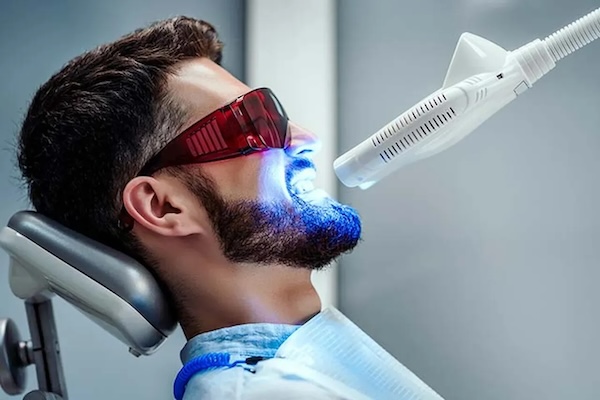Hi everyone, my name is Dr. Lea Planzos and I'm a periodontist. Today I'm going to answer the most commonly asked questions about the LANAP procedure.
What is LANAP?
LANAP stands for laser-assisted new attachment procedure, and it's essentially a laser treatment used to treat patients with gum disease.
How does LANAP differ from traditional gum surgery?
LANAP is technically not a surgical procedure. There's no cutting or stitching involved. We use a laser to disinfect around the teeth, followed by a piezoelectric ultrasonic device used three times underneath the gums to clean the teeth thoroughly. It's followed by a second pass with the laser at a different setting, which disinfects again and promotes hemostasis, essentially coagulation of any bleeding around the teeth, serving almost like a liquid bandage.
Is the LANAP procedure painful?
The LANAP procedure requires dental anesthesia, local anesthesia, so patients are awake during the procedure and numb. It should not be painful once numbed.
What is the recovery time after LANAP?
By and large, there's minimal recovery time afterward. Most of my patients can carry on with their normal routines the next day.
Who is a good candidate for LANAP?
A good candidate for LANAP would be anyone with inflammation of their gums, from gingivitis to periodontitis, which is gum disease, or anyone who has ailing or failing implants. The procedure is actually called LAIP when treating implants, and you can treat a single implant using the same protocol.
What are the benefits of LANAP over traditional surgery?
The benefits of LANAP over traditional surgery are that it's much less invasive. There's no cutting with a blade, no stitches, and there can be less recession afterward, so the tissue doesn't shrink back as much. Reports suggest a lot less cold sensitivity after laser treatment with LANAP compared to traditional surgery.
How effective is LANAP for treating gum disease?
LANAP has proven to be extremely effective against gum disease. It's important to note that periodontal disease and gum disease are chronic diseases, requiring lifelong maintenance. However, it can be an excellent alternative to traditional therapies.
What kind of laser is used in LANAP?
The laser used to perform the LANAP protocol is called the Periolase MVP-7 laser. It's used at a 1064-nanometer wavelength and is the only laser approved for the LAN procedure, which is a patented protocol.
Can LANAP reverse gum disease?
LANAP can arrest the process of gum disease and is FDA approved for the regeneration of bone and tissue around the teeth. It may not happen 100% of the time, but overall we have great results.
Thank you. I hope I answered some of your important questions. Have a great day.

Laser dentistry provides a quick, convenient, and pain-free alternative to traditional oral health care. At Impressive Dental Care in the Bay Ridge neighborhood of Brooklyn, New York, Lea Planzos, DMD, MS, Penny Planzos, DMD, MS, and Thomas Planzos, DMD, use laser dentistry to diagnose cavities, treat gum disease, do root canal therapy, and more. To make an appointment today, call the office or book online.
What is laser dentistry?
Laser dentistry uses targeted light energy to change or remove your mouth’s hard and soft tissues. Dental lasers provide greater accuracy and precision, resulting in fewer side effects, quicker recovery times, and improved treatment outcomes.
What problems can laser dentistry treat?
Impressive Dental Care uses laser dentistry for various reasons, including:
- Canker sore treatment
- Root canal therapy
- Gum lifts
- Cosmetic gum contouring
- Exposing the wisdom teeth for extraction
- Sleep apnea treatment
- Detecting cavities
- Preparing teeth for dental fillings
- Tooth sensitivity treatment
You might also benefit from laser dentistry if you have a benign (noncancerous) oral abscess or tumor.
What kinds of laser dentistry are there?
Impressive Dental Care offers two kinds of laser dentistry:
Soft-tissue laser dentistry
Soft-tissue laser dentistry treats problems affecting the soft tissues in your mouth — the gums, tongue, and cheeks. The lasers vaporize the tissue, sealing exposed blood vessels at the same time.
Hard-tissue laser dentistry
Hard-tissue laser dentistry treats problems affecting your tooth enamel and bone. The lasers use powerful wavelengths capable of cutting through calcium phosphate; the material bone is made of.
What are the benefits of laser dentistry?
Laser dentistry offers several benefits, including:
- Faster healing times
- Less bleeding after surgery
- Less pain
- Reduced need for anesthesia
- Lower chance of infection
Laser dentistry is also pinpoint accurate, meaning less healthy tissue will be removed.
What happens during laser dentistry?
Laser dentistry is similar to traditional dentistry. The difference is that your Impressive Dental Care provider uses lasers instead of conventional hand-held dental tools. Lasers are much easier on your gums and tooth enamel than metal. As a result, you won’t hear any scraping during treatment.
Laser dentistry is comfortable and pain-free. But if you experience dental anxiety or have a sensitive gag reflex, let your provider know. Impressive Dental Care can give you nitrous oxide (laughing gas) to relax you.
What is recovery like after laser dentistry?
After laser dentistry, you might experience increased sensitivity and swelling, but these symptoms should go away within 24 hours. If they persist, contact Impressive Dental Care immediately. In the meantime, get plenty of rest, drink lots of water, and take anti-inflammatory medicine (ibuprofen, acetaminophen, aspirin) if necessary.
To see if you’re a candidate for laser dentistry, make an appointment today at Impressive Dental Care by calling the office or booking online.

